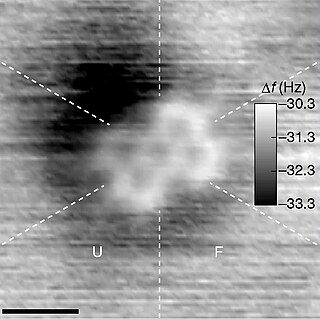The molecular formula C19H16O3 (molar mass: 292.33 g/mol, exact mass: 292.1099 u) may refer to:
The molecular formula C19H16O3 (molar mass: 292.33 g/mol, exact mass: 292.1099 u) may refer to:
A chemical formula is a way of presenting information about the chemical proportions of atoms that constitute a particular chemical compound or molecule, using chemical element symbols, numbers, and sometimes also other symbols, such as parentheses, dashes, brackets, commas and plus (+) and minus (−) signs. These are limited to a single typographic line of symbols, which may include subscripts and superscripts. A chemical formula is not a chemical name, and it contains no words. Although a chemical formula may imply certain simple chemical structures, it is not the same as a full chemical structural formula. Chemical formulae can fully specify the structure of only the simplest of molecules and chemical substances, and are generally more limited in power than chemical names and structural formulae.

A molecule is a group of two or more atoms held together by attractive forces known as chemical bonds; depending on context, the term may or may not include ions which satisfy this criterion. In quantum physics, organic chemistry, and biochemistry, the distinction from ions is dropped and molecule is often used when referring to polyatomic ions.
The molecular mass (m) is the mass of a given molecule: it is measured in daltons. Different molecules of the same compound may have different molecular masses because they contain different isotopes of an element. The related quantity relative molecular mass, as defined by IUPAC, is the ratio of the mass of a molecule to the unified atomic mass unit and is unitless. The molecular mass and relative molecular mass are distinct from but related to the molar mass. The molar mass is defined as the mass of a given substance divided by the amount of a substance and is expressed in g/mol. That makes the molar mass an average of many particles or molecules, and the molecular mass the mass of one specific particle or molecule. The molar mass is usually the more appropriate figure when dealing with macroscopic (weigh-able) quantities of a substance.
In chemistry, the molar mass of a chemical compound is defined as the mass of a sample of that compound divided by the amount of substance which is the number of moles in that sample, measured in moles. The molar mass is a bulk, not molecular, property of a substance. The molar mass is an average of many instances of the compound, which often vary in mass due to the presence of isotopes. Most commonly, the molar mass is computed from the standard atomic weights and is thus a terrestrial average and a function of the relative abundance of the isotopes of the constituent atoms on Earth. The molar mass is appropriate for converting between the mass of a substance and the amount of a substance for bulk quantities.
The molecular formula C6H6 (molar mass: 78.114)
The molecular formula C4H6 (molar mass: 54.09 g/mol) may refer to:
The molecular formula C5H12O (molar mass: 88.15 g/mol, exact mass: 88.088815) may refer to:
The molecular formula C6H6O4 (molar mass : 142.10 g/mol, exact mass : 142.026608 u) may refer to:
The molecular formula C6H12O4 (molar mass: 148.15 g/mol, exact mass: 148.073559) may refer to:
The molecular formula C9H8O4 (molar mass: 180.15 g/mol, exact mass: 180.042259 u) may refer to:
The molecular formula C9H11NO2 (molar mass: 165.18 g/mol, exact mass: 165.078979) may refer to:
The molecular formula C7H6O2 (molar mass: 122.12 g/mol, exact mass: 122.036779 u) may refer to:
The molecular formula C14H12O2 (molar mass : 212.24 g/mol, exact mass: 212.08373 u) may refer to:
The molecular formula C10H16N2O8 (molar mass: 292.244 g/mol) may refer to:
The molecular formula C11H15NO2 (molar mass : 193.24 g/mol, exact mass : 193.110279) may refer to:
The molecular formula C10H10O3 (molar mass : 178.185 g/mol, exact mass : 178.062994 u) may refer to :
The molecular formula C18H12O4 (molar mass: 292.28 g/mol, exact mass: 292.0736 u) may refer to:
The molecular formula C7H11NO4 (molar mass: 173.17 g/mol, exact mass: 173.0688 u) may refer to:
The molecular formula C20H24N2 (molar mass: 292.42 g/mol, exact mass: 292.1939 u) may refer to:
The molecular formula C15H17ClN2O2 (molar mass: 292.76 g/mol) may refer to: